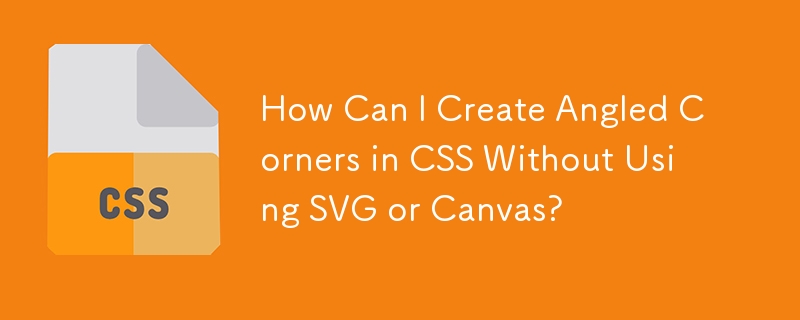How Can I Create Angled Corners in CSS Without Using SVG or Canvas?

Angled Corners in CSS: A Cutting-Edge Technique
Designing an aesthetically pleasing website can be challenging, especially when it comes to creating angled corners. However, with the advancements in CSS, it's now possible to achieve this effect without resorting to non-native methods like SVG or canvas.
Creating the Angled Corner
To create an angled corner, we can leverage the :before and :after pseudo-elements along with a parent container. By manipulating the position, border styles, and offsets of these elements, we can effectively block out a corner while preserving the border.
Step 1: Container Border
Begin by adding a border to the container element to define the outer boundaries of our angled corner.
Step 2: :before Pseudo-Element
Next, add the :before pseudo-element to cut off the desired corner. Position it absolutely, with a negative offset of -1px to cover the border. Apply a solid border to the top and a transparent border to the right to create the slanted line.
Step 3: :after Pseudo-Element
To create the line inside the cut-off, add the :after pseudo-element with a slightly smaller offset of -2px. Give it a solid white border to the top and a transparent border to the right.
Example Implementation
The following CSS code demonstrates how to apply these principles:
.cutCorner {
position:relative; background-color:blue;
border:1px solid silver; display: inline-block;
}
.cutCorner img {
display:block;
}
.cutCorner:before {
position:absolute; left:-1px; top:-1px; content:'';
border-top: 70px solid silver;
border-right: 70px solid transparent;
}
.cutCorner:after {
position:absolute; left:-2px; top:-2px; content:'';
border-top: 70px solid white;
border-right: 70px solid transparent;
}This code can be used to wrap an image element within a container, resulting in an image with the specified angled corner.
Alternative Approach
While CSS techniques can provide a solution, if precise control over the angled corner is required or additional features like masking or image clipping are desired, using SVG or canvas may be a more suitable approach.
The above is the detailed content of How Can I Create Angled Corners in CSS Without Using SVG or Canvas?. For more information, please follow other related articles on the PHP Chinese website!

Hot AI Tools

Undresser.AI Undress
AI-powered app for creating realistic nude photos

AI Clothes Remover
Online AI tool for removing clothes from photos.

Undress AI Tool
Undress images for free

Clothoff.io
AI clothes remover

AI Hentai Generator
Generate AI Hentai for free.

Hot Article

Hot Tools

Notepad++7.3.1
Easy-to-use and free code editor

SublimeText3 Chinese version
Chinese version, very easy to use

Zend Studio 13.0.1
Powerful PHP integrated development environment

Dreamweaver CS6
Visual web development tools

SublimeText3 Mac version
God-level code editing software (SublimeText3)

Hot Topics
 1377
1377
 52
52
 Working With GraphQL Caching
Mar 19, 2025 am 09:36 AM
Working With GraphQL Caching
Mar 19, 2025 am 09:36 AM
If you’ve recently started working with GraphQL, or reviewed its pros and cons, you’ve no doubt heard things like “GraphQL doesn’t support caching” or
 Making Your First Custom Svelte Transition
Mar 15, 2025 am 11:08 AM
Making Your First Custom Svelte Transition
Mar 15, 2025 am 11:08 AM
The Svelte transition API provides a way to animate components when they enter or leave the document, including custom Svelte transitions.
 Show, Don't Tell
Mar 16, 2025 am 11:49 AM
Show, Don't Tell
Mar 16, 2025 am 11:49 AM
How much time do you spend designing the content presentation for your websites? When you write a new blog post or create a new page, are you thinking about
 Building an Ethereum app using Redwood.js and Fauna
Mar 28, 2025 am 09:18 AM
Building an Ethereum app using Redwood.js and Fauna
Mar 28, 2025 am 09:18 AM
With the recent climb of Bitcoin’s price over 20k $USD, and to it recently breaking 30k, I thought it’s worth taking a deep dive back into creating Ethereum
 How do you use CSS to create text effects, such as text shadows and gradients?
Mar 14, 2025 am 11:10 AM
How do you use CSS to create text effects, such as text shadows and gradients?
Mar 14, 2025 am 11:10 AM
The article discusses using CSS for text effects like shadows and gradients, optimizing them for performance, and enhancing user experience. It also lists resources for beginners.(159 characters)
 What the Heck Are npm Commands?
Mar 15, 2025 am 11:36 AM
What the Heck Are npm Commands?
Mar 15, 2025 am 11:36 AM
npm commands run various tasks for you, either as a one-off or a continuously running process for things like starting a server or compiling code.
 Creating Your Own Bragdoc With Eleventy
Mar 18, 2025 am 11:23 AM
Creating Your Own Bragdoc With Eleventy
Mar 18, 2025 am 11:23 AM
No matter what stage you’re at as a developer, the tasks we complete—whether big or small—make a huge impact in our personal and professional growth.
 Let's use (X, X, X, X) for talking about specificity
Mar 24, 2025 am 10:37 AM
Let's use (X, X, X, X) for talking about specificity
Mar 24, 2025 am 10:37 AM
I was just chatting with Eric Meyer the other day and I remembered an Eric Meyer story from my formative years. I wrote a blog post about CSS specificity, and




